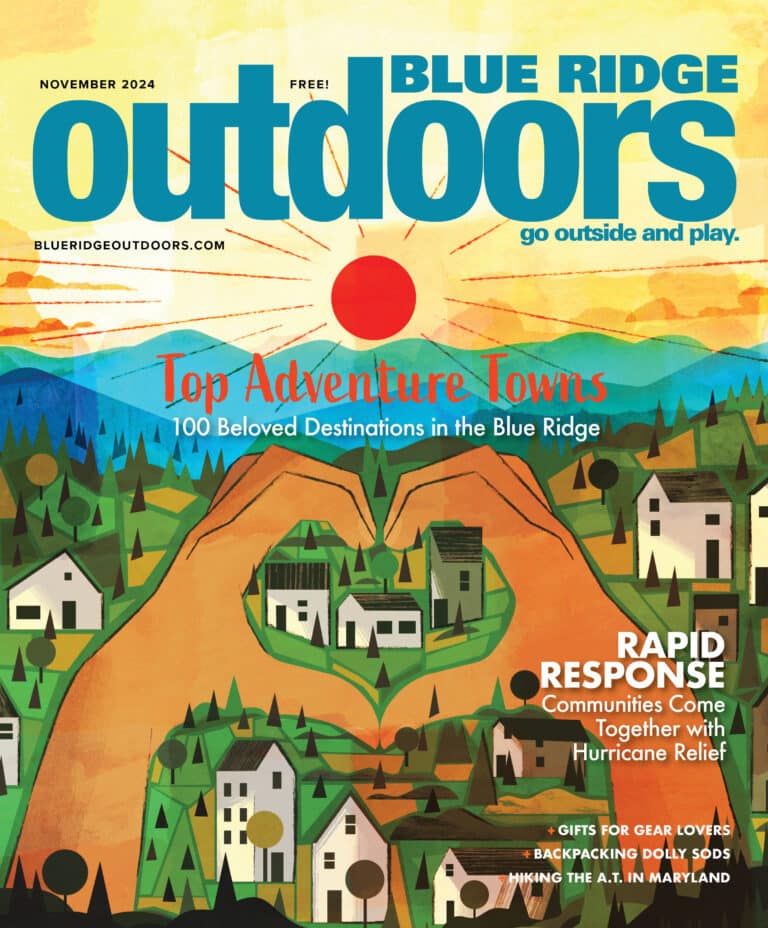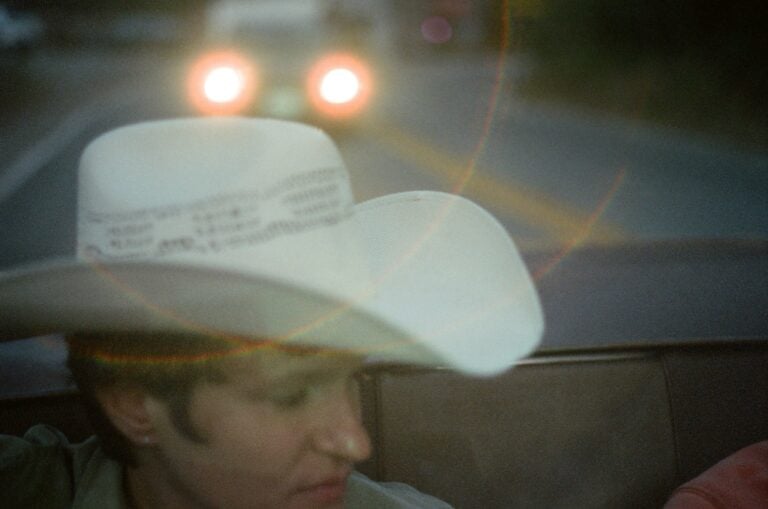
We’re probably not going to die today. It’s a comforting fact that I feel compelled to repeat to my two hiking partners as we stand in a circle, looking over two different topo maps and a digital compass trying to figure out where we are—and more importantly, how we’re going to walk out of this jungle before nightfall.
I don’t use the term jungle lightly. For the last eight hours, we’ve been bushwhacking the Anakeesta Ridge on the east side of the Great Smoky Mountains National Park. Anakeesta is a sharp ridgeline that rises steeply from Newfound Gap Road and undulates above 5,500 feet before topping out at 5,988-foot Anakeesta Knob. There is no trail on Anakeesta Ridge, just a wild, foreboding jungle replete with black bear scat, salamanders, eerie white moss, blackberry, blueberry, vertical cliffs, killer briars, towering spruce fir, and rhododendron. Miles and miles of rhododendron. And we’ve pushed, crawled, climbed, and bled our way through the worst of it in order to bag the knob and soak in the incredible views from the narrow ridgeline. But the intoxication from those remote views is long gone as we twist the maps and hypothesize about which direction is home.
We’ve got two hours before sunset, but probably less than an hour before it gets too dark to bushwhack through the thick canopy that surrounds us. We’re tired, bleeding, and soaked from a day of rain. We’re not prepared to spend the night in the woods, and I picture the three of us canoodling beneath a tree for warmth and arm wrestling for the last piece of trout jerky.

“Man, I am so glad we didn’t bring a GPS,” says one of my buddies, Jeff Keener (who has earned the nickname Captain Negative), as he spins around in a circle three times trying to recalibrate his watch compass.
His sarcasm is superfluous given our current situation. Besides, any experienced woodsman will tell you a GPS is no substitute for solid map and compass skills. What Captain Negative should be griping about is the fact that none of us are experienced woodsmen and our map and compass skills suck.
To be fair, both Captain Negative and my other cohort, Jeremiah LeRoy, raised legitimate concerns about the safety of this trip and the soundness of my navigation skills well in advance. But like I told the boys in a series of reassuring e-mails, our plan is simple: all we’re going to do is climb 1,000 feet of elevation through thick rhododendron without a trail, then bushwhack two miles along a knife-edge ridgeline, and then navigate to the Boulevard Trail and connect that with the A.T.—all with just a digital compass, a topo map, and questionable backcountry skills. What could possibly go wrong?

help from george michael
If Anakeesta Knob were 12 feet higher, there’d be a heavily-used, doubletrack trail to its summit. But at 5,988 feet, because it’s not a “sixer” and the fact that the knob itself offers no views whatsoever, it’s remained “off the map.” The ridge itself is razor thin—10 feet at its widest and 10 inches at its most narrow. On either side of that skinny peak, the mountain drops dramatically toward the forest floor. The slopes along Anakeesta are so steep, they’re known for massive rock slides—avalanches of shaky slate-like rock that have left permanent gray scars on the landscape. The rock scars and steep slopes make Anakeesta look unforgiving as you get your first peek of the mountain from Newfound Gap Road.
“It’s one of the hardest bushwhacks I’ve ever done,” says Peter Barr, an avid off-trail hiker who oversees the Carolina Mountain Club’s South Beyond 6,000 Challenge. Many of the 40 “sixers” that comprise that peak-bagging challenge require bushwhacks, but they’re nothing compared to what you find on Anakeesta. What makes Anakeesta so tough is the combination of thick briars, rock cliffs, and a skinny ridgeline that drops dramatically on either side.
“You’re looking at a true knife-edge ridge that makes the Sawteeth look wide,” Barr says. “And that few inches of crest is obstructed with mountain laurel, rhododendron, and spruce-fir. You’ve got more than a mile of this with no trail.”
I like the irony of a trip like this. Anakeesta sits only a couple of miles from Newfound Gap and one of the more popular sections of the A.T. In fact, this wild ridge is surrounded by three of the most popular trails in the park (the A.T., Alum Cave, and Boulevard) and yet the terrain is so foreboding that only a handful of hikers ever bother to tackle its scarred face. The Smokies has a reputation for being crowded (more than 9 million visitors a year) and Newfound Gap itself is often referred to as a zoo, but the solitude you can find on Anakeesta proves that if you’re willing to go just a few miles off trail, you can have the park all to yourself. Even more surprising? There’s nothing illegal about bushwhacking to remote peaks like Anakeesta.
“Except for a couple of places, you can walk anywhere you want inside the park,” says Bob Miller, information officer for the GSMNP. “But we discourage it for safety reasons. When you leave the road, you leave the ambulance behind. When you leave the trail, you leave a swift rescue behind. The further you go off trail, the more impact you have on your rescue response.”
The possibility of needing a rescue first pops into my mind during a creek crossing less than 100 yards from the road. The forest on Anakeesta’s lower slope is relatively open, but the rain was coming down steadily, and the log I chose to cross a narrow, rocky stream was slick. So were my boots. The short, painful fall into the creek made me wonder if I hadn’t underestimated the difficulty of the task at hand.
At first, the slope is so steep, we have to grip sturdy branches to pull ourselves upward, but soon, the terrain mellows and we find ourselves on our bellies, trying to squeeze through tiny openings between the tangle of brown, wet limbs or rhododendron. Rhodo branches grow horizontally as well as vertically, and they’re too strong to muscle through. As a result, we end up hugging the ground, trying to stay below the madness.
The brush only opens up where massive blowdowns create pockets of space, allowing us to stand erect on top of dead trees and take stock of our general location. For 50 yards, we’re able to string a few downed trees together, hopping from one dead tree to the next. But soon, it’s back to the belly crawl. In places, the foliage is so thick, I can’t see Jeremiah or Captain Negative at all. I can only see the bushes move behind me. My daypack gets wedged in the branches so often, I consider ditching it altogether.
I want to keep morale high, so I start singing George Michael’s “Faith.” It’s an appropriate song given our situation. Bushwhacking is like religious fanaticism. It takes a sense of faith and optimism that borders insanity. You have to believe in your heart that everything is going to work out in the end, even though the details you’re surrounded by would lead most to believe the contrary. You are boldly going where few men have gone before. You have to have faith that you’re going the right way. Faith that you’re not going to break a leg. Faith that you’re not going to bushwhack for two miles and get stalled by an impassable cliff. Faith that you’re not going to have to spend the night in the woods shivering without enough food and water.
In the immortal words of George Michael, “you’ve got to have faith, faith, faith.”
without a trace
Three hours later we reach the ridgeline. We’ve traveled only half a mile. Some quick math puts us at a blistering pace of 0.16 miles per hour.
“I don’t think we’re gonna make it before dark,” Captain Negative says, examining the contents of his pack, all of which are soaked from the rain.
“Of course we’re gonna make it,” I lie. “I bet the ridge opens up from here.”
The ridge doesn’t open up at all. It’s as choked with as much rhodo, blueberry, and spruce fir as the climb we just finished. Only now, we have to climb up and over massive dead-fall that cross the narrow crest. These downed trees were a respite during the morning’s climb, but on the narrow ridge, they’re booby traps. A fall from one of the thick trunks would mean a vertical drop off the skinny ridge. We navigate them slowly, climbing up massive, dead trunks and testing the strength of rotting limbs before we use them to swing our bodies onto solid ground.
This sort of bushwhacking might not be against park regulations, but it’s certainly shrouded in an ethical quandary because of the potential environmental degradation involved. There are mixed feelings about bushwhacking among Leave No Tracers. If done properly, bushwhacking presents no significant threat to the ecosystem. If done haphazardly, it can be a disaster.
“Hiking off-trail is an individual decision,” says Sarah Folzenlogen, the education program director for Leave No Trace. “But if you’re hiking in a popular area like the Smokies, it’s best to stick to the established trails. People model their behavior on what they see other people do. The Smokies is the most visited park in the country. Imagine the impact of thousands of bushwhackers in that park.”
A massive off-trail hiking movement is difficult to fathom, especially in the Smokies where “front country” travel is so popular. Truth is, very few people would find traversing the Anakeesta Ridge appealing. The Smoky Mountains Hiking Club has a long tradition of off-trail hikes, dating back to the ‘20s before the area was a national park. But even their guided bushwhacking adventures are becoming less popular. Still, experienced hikers crave the solitude and challenge of a decent bushwhack.
Ed Fleming, vice president of the hiking club, believes appropriately planned off-trail hikes even disperse some of the impact of hikers. “If the group size is kept small, and the areas hiked aren’t overused, then off-trail hiking has less impact on the environment than the use and maintenance of popular trails.”

razor’s edge
The vertigo hits as soon as my boots touch the fin of rock, sending thin slices of slate tumbling down the cliff line.
As we bushwhacked eastward along the ridge, the terrain had been getting progressively rockier, offering periodic views of the surrounding mountains. Now we’re standing at the precipice of “the razor,” a rocky crest that’s no wider than ten inches across. Rock slides drop from both sides, creating a short-but-harrowing seam that’s completely exposed. Slip, and you’re looking at a 500-foot drop. But big views of the remote basins that make up Huggins Hell roll away below us.
I drop to my hands and knees to crawl across the narrow, flaky crest. Once we’re all safe on wider ground, we take a break to enjoy this tangible reward. The view is particularly sweet when you realize maybe a dozen people have enjoyed it in recent years. Huggins Hell, to our left, looks wild from our perch. More rock slides scar its steep slopes.
This is the sort of solitude that we were looking for. The only signs of man we’ve seen on Anakeesta since we left the road were a couple of sagging helium balloons still attached to their strings. I imagine a mess of them being released at a birthday party in Gatlinburg. If you ever wondered where those balloons end up after they disappear into the horizon, some of them end up here.
Looking into Huggins Hell, I’m drunk on the solitude. “If we stumble across a lost Native American civilization that’s still living traditionally, I get to name them.”
“How very white of you,” Jeremiah says.
keeping the faith
We see increasing amounts of bear scat as we hike to the peak of Anakeesta Knob, stopping at the true summit to congratulate each other in a “mission accomplished” moment. The knob itself is unimpressive: more evergreens and rhodo.
We drop off the peak in what we believe is the general direction of Boulevard Trail, our avenue back to the plush digs of my Volkswagen Jetta. The trail is just 100 yards from the knob.
An hour later we’re still pecking around the steep slopes off Anakeesta Knob praying Boulevard, or any trail, is just around the next corner. We can’t come to a consensus about our approximate location. Captain Negative thinks we’re on the north side of Anakeesta Knob. I think we’re on the east side. Jeremiah thinks his knee hurts. The only thing we all agree on is that we don’t want to sleep out here tonight.
We continue heading east hoping we’ll hit the trail, but according to the altimeter, we’re dropping too much elevation. Boulevard is a ridgeline trail, and we’re dropping to 5,000 feet. We stop again to look at the maps. A decision has to be made. We either abandon all hope and start hiking down the slope in the general direction of Newfound Gap Road, or we hike up the slope, taking us farther into the backcountry in hopes of coming across the trail.
Bushwhacking towards the road is the safest choice, and has been our evacuation route all along, but it almost guarantees us a night in the woods. We’re only a few miles from the road, but if we move at our record-setting 0.16 mile-per-hour pace, we wouldn’t make it a mile before we had to stop for the night. Heading up the slope still leaves a chance we’ll make it to the car tonight, but we run the risk of getting farther off course.
We decide to keep the faith and continue looking for Boulevard Trail. We change our course and start hiking north, up the slope, trying to move quickly over a forest floor covered with ferns and packed with evergreens. We’re quiet now. No more singing George Michael. No more naming lost tribes. Silently, we’re all thinking the same thing: our wives are going to kill us.
Soon, we begin to see faint patches of light between the branches of the highest trees ahead of us. Still clinging to foolish optimism, I say the light means a ridge is near, probably even our trail. I’m not convinced of this until I see some used toilet paper hanging from a low branch. Aside from the wayward balloons, this trash is the first sign of man we’ve seen all day. Feces mean people. People mean trail.
We climb ten yards past the toilet paper and pull ourselves onto the ridgeline and set foot on the beautiful, graveled Boulevard Trail. Immediately, the group is all smiles and high fives again. As always, I learn nothing from the near-disaster. Instead of acquiescing about the validity of carrying a backup GPS, or running to enroll in the next navigation skills course of my local orienteering club, I spend the six-mile hike out of the woods boasting about my “God-given internal GPS” and singing George Michael louder than ever. •







